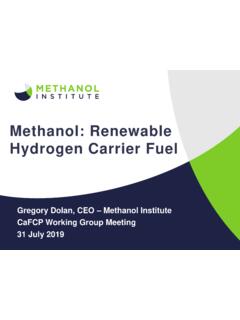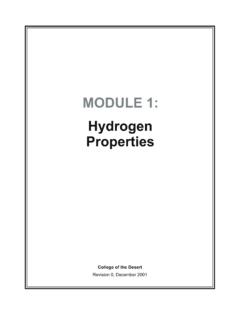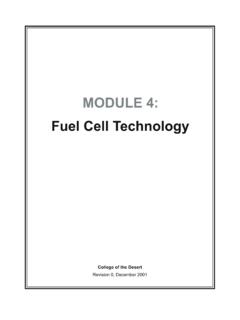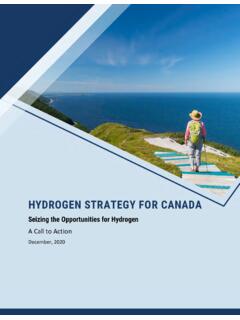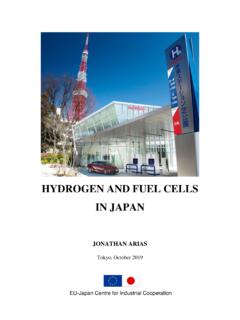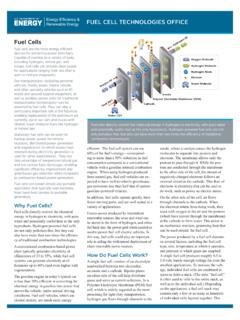Transcription of An Introduction to SAE Hydrogen Fueling Standardization
1 1 | fuel Cell Technologies Office An Introduction to SAE Hydrogen Fueling Standardization Will James Department of Energy fuel Cell Technologies Office 2 | fuel Cell Technologies Office 2 Question and Answer Please type your question into the question box SAE INTERNATIONAL DOE WEBINAR: An Introduction to SAE Hydrogen Fueling Standardization SAE INTERNATIONAL PARTICIPANTS AND AGENDA 4 DOE WEBINAR: An Introduction to SAE Hydrogen Fueling Standardization Will James - Moderator Jesse Schneider - SAE J2601 Standard Hydrogen Fueling Protocol - SAE J2799 Standard FCEV Communications Steve Mathison - SAE J2601 Development Fueling - MC Method Webinar Q&A SAE INTERNATIONAL DOE Webinar: Introduction to SAE H2 Fueling Standardization 5 SAE Hydrogen Fueling Standardization Jesse Schneider (BMW) SAE J2601 & J2799 Sponsor SAE INTERNATIONAL Hydrogen Fueling Background SAE H2 Fueling Standardization SAE J2799 Standard SAE J2601 Standard Lab Testing and Field Verification of Hydrogen Fueling Implementing of SAE J2601 DOE Webinar: Introduction to SAE H2 Fueling Standardization 6 Outline SAE INTERNATIONAL Hydrogen Fueling Background SAE H2 Fueling Standardization SAE J2799 Standard SAE J2601 Standard Lab Testing and Field Verification of Hydrogen Fueling Implementing of SAE J2601 7 Outline DOE Webinar: Introduction to SAE H2 Fueling Standardization SAE INTERNATIONAL Worldwide Hydrogen Infrastructure Developments Status 2014 8 Europe.
2 Germany Demo-project Clean Energy Partnership 15 public stations + 35 in process in 2016 400 Privately funded in planning until 2023 Scandinavian Countries Scandinavian Hydrogen Highway, 10 public stations / 6 in process/ 15 planned for 2016+. Japan 100 stations planned until 2016+ 1000 stations in discussion until 2025 California / US ZEV Mandate 10 public station, / 45 more in process for 2016 (100 Total planned) US/ East Coast East Coast Hydrogen Highway evaluation (TBD) 8 DOE Webinar: Introduction to SAE H2 Fueling Standardization Source: State of California, Clean Energy Partnership, HySUT SAE INTERNATIONAL Major Automakers recently announced their plans in Hydrogen fuel cell electric vehicles (BMW-Toyota / Daimler-Ford-Nissan / Honda-GM / Hyundai) The State of California announced plans funding for 100 H2 stations to support FCEVs The US DOE along with the industry and partnerships created a new Hydrogen initiative called H2 USA to coordinate a national Hydrogen infrastructure in the US (including assisting with C&S.)
3 H2 USA is also working with the DOE project called H2 FIRST to accelerate the technology needed for the Fueling infrastructure. This new project brings important federal know-how and resources to accelerate improvements in refueling infrastructure that support the commercial market launch of Hydrogen fuel cell vehicles, said Air Resources Board Chairman Mary D. Nichols. California is committed to deploying at least 100 Hydrogen refueling stations in the next decade, and the H2 FIRST effort is a big step toward the development and deployment of a broader, consumer-friendly infrastructure for us and the rest of the United DOE Webinar: Introduction to SAE H2 Fueling Standardization 9 US Status of Hydrogen for vehicles: Creating the First Generation of Infrastructure National and Local Organizations SAE INTERNATIONAL Hydrogen Fueling is critical to the success of fuel Cell Electric Vehicles (or Hydrogen Surface Vehicles, HSV) Factors for success: Fueling has to be within Hydrogen storage system limits.
4 Fueling rate and driving range have to be acceptable to customer Vehicles need to fuel at same as today s rate. Hydrogen Fueling is the only ZEV infrastructure technology proven to achieve same as today s fuel delivery rates and equivalent driving range for all vehicle segments. Hydrogen Fueling Background Why is it important ? 10 DOE Webinar: Introduction to SAE H2 Fueling Standardization SAE INTERNATIONAL Zero Emission Vehicles Reference Comparison: BEV Charging vs. FCEV Hydrogen Fueling 11 DOE Webinar: Introduction to SAE H2 Fueling Standardization SAE INTERNATIONAL Hydrogen Fueling Background SAE H2 Fueling Standardization SAE J2799 Standard SAE J2601 Standard Lab Testing and Field Verification of Hydrogen Fueling Implementing of SAE J2601 DOE Webinar: Introduction to SAE H2 Fueling Standardization 12 Outline SAE INTERNATIONAL Path to Hydrogen Fueling Standardization Guideline to SAE Standards Hydrogen Coupling: SAE J2600 Hydrogen Gas Quality for FCEVs: SAE J2719 Hydrogen Fueling : FCEV to Station Communications: SAE J2799 Light Duty Vehicles: SAE J2601 Heavy Duty Vehicles: SAE J2601-2 Fork Lift Vehicles: SAE J2601-3 DOE Webinar: Introduction to SAE H2 Fueling Standardization 13 SAE INTERNATIONAL Path to SAE Hydrogen Fueling Standardization Guideline to Standards DOE Webinar.
5 Introduction to SAE H2 Fueling Standardization 14 OEM H2 Fueling Rev A 2007 SAE INTERNATIONAL Hydrogen Fueling Background SAE H2 Fueling Standardization SAE J2799 Standard SAE J2601 Standard Lab Testing and Field Verification of Hydrogen Fueling Implementing of SAE J2601 DOE Webinar: Introduction to SAE H2 Fueling Standardization 15 Outline SAE INTERNATIONAL Transparent to customer Wireless, IrDA is an Available Technology Vehicle / tank information used for improving Fueling Enables consistent 95-100% SOC Fueling Optional Vehicle Abort Signal to stop Fueling SAE J2799 Standard Wireless FCEV to Hydrogen Station Standard DOE Webinar: Introduction to SAE H2 Fueling Standardization 16 SAE INTERNATIONAL DOE Webinar: Introduction to SAE H2 Fueling Standardization 17 SAE J2799 Signals Transferred Note: For the SAE Table-based Fueling Protocol, the Optional Data Command is ignored. It is reserved for future revisions of J2601.
6 SAE INTERNATIONAL Hydrogen Fueling Background SAE H2 Fueling Standardization SAE J2799 Standard SAE J2601 Standard Lab Testing and Field Verification of Hydrogen Fueling Implementing of SAE J2601 DOE Webinar: Introduction to SAE H2 Fueling Standardization 18 Outline SAE INTERNATIONAL SAE J2601 (also with J2799) fuels all Hydrogen storage systems quickly to a high state of charge (SOC) without violating the storage system operating limits of internal tank temperature or pressure. SAE J2601 meets the DOE FCEV Targets for 2017 by enabling a Hydrogen Fueling in 3 minutes* which enables a 300+ miles (500 km) range SAE J2601/J2799 is being used as a basis for FCEV Fueling worldwide. SAE J2601 Enabling 3 minute Fueling and 300+ miles range * H70-T40 dispenser, 4-7 kg H2 storage; Reference Ambient Temperature 20C DOE Webinar: Introduction to SAE H2 Fueling Standardization 19 SAE INTERNATIONAL After 12 years of work, the SAE J2601 was released in 2014 as a standard.
7 What is SAE J2601? First World-Wide Light Duty Hydrogen Vehicle Fueling Standard for 35 & 70 MPa : Created by Math Modeling, Confirmed by Real OEM System Testing in both the lab and field. What does the J2601 standard cover? Light Duty Hydrogen Vehicle Fueling (2-10kg@70 MPa / @35 MPa) Fueling Protocol with & without communications Defines Safety Limits and Performance Targets. Table-Based Approach (relaxed from TIR Levels) New Fueling Temperature Categories New Fueling Concepts (update from TIR): Fall-Back , Top-Off , Cold Dispenser , Development MC Method SAE J2601 LD Summary DOE Webinar: Introduction to SAE H2 Fueling Standardization 20 SAE INTERNATIONAL SAE J2601 Steps to Standardization FCEV Hydrogen Fueling Simulation Model was created to develop J2601 Look-up Table with industry input Modeling of Real Tank Properties (from OEMs) Modeling of Real Station Components (from H2 Suppliers) Correlation of Models between OEMs Lab Validation with Extreme Temperatures and FCEV Tank Volume Sizes.
8 Testing with OEM Tanks H2 Supplier Station Hardware J2601 Protocol Field Validation at H2 Stations in Field with real FCEVs Field Testing of Stations at Public Locations in three continents Numerous OEMs FCEV participated DOE Webinar: Introduction to SAE H2 Fueling Standardization 21 SAE INTERNATIONAL Technical Goals for Compressed Hydrogen Fueling Maintain the safety limits of storage system. Minimum/ Maximum Gas Temperature: -40 C / 85 C Maximum Dispenser Pressure: MPa (70 MPa NWP) and MPa (35 MPa NWP) Maximum Flow Rate: 60 g/s Achieve target desired customer attributes. Fueling Time: 3 minutes (T70-H70) Typical State of Charge Range : 90% to 100% (density based on NWP at 15 C) Options for Compressed Hydrogen Fueling Protocol Vehicle to station interface strategies Communication: vehicle provides tank parameters through an electrical interface Non-communication: vehicle provides tank pressure only Station key control factors Pre-cooling of Hydrogen : station conditions H2 temperature prior to dispensing Hydrogen delivery rate: station provides average pressure rise rate as per the tables Fill termination: station determines end pressure and/or density based on tables DOE Webinar: Introduction to SAE H2 Fueling Standardization 22 SAE J2601 Hydrogen Fueling Protocol Approach SAE INTERNATIONAL DOE Webinar: Introduction to SAE H2 Fueling Standardization 23 SAE J2601-2014, Compressed Hydrogen Storage System Table Capacity Categories 70 MPa (3 Categories).
9 2-4 kg / 4-7kg / 7-10kg 35 MPa (2 Categories) : / SAE INTERNATIONAL DOE Webinar: Introduction to SAE H2 Fueling Standardization 24 J2601-2014 Standard vs. TIR J2601-2010 Table Hydrogen Gas Temperature Ranges for Dispenser s J2601 Standard defines Fueling station dispenser type by capability to dispense Hydrogen fuel at a specific pre-cooled or Hydrogen gas temperature range. No Shutdowns in new standard. A B C Shutdown if out of tolerence No Shutdowns and allow for Fall-Back Fueling SAE INTERNATIONAL Fueling Fundamentals Fueling Limits and SAE J2601 Tables Line of Constant Density fuel all Hydrogen storage systems quickly to a high state of charge (SOC) Keep within the storage system operating limits of internal tank temperature (don t overheat) or upper limits of pressure (don t overpressure) DOE Webinar: Introduction to SAE H2 Fueling Standardization 25 SAE INTERNATIONAL DOE Webinar: Introduction to SAE H2 Fueling Standardization 26 SAE J2601 Hydrogen Fueling Pressure vs.
10 Temperature Development in Vehicle Tank Average Pressure Ramp Rate SAE INTERNATIONAL Fueling Fundamentals Lookup Table Control Methodology Ambient Temp. Delivered Gas Temp. Initial Gas Pressure Vehicle Parameters Station Parameters Average Pressure Ramp Rate Target (End) Pressure SAE J2601-2014 Fueling Standard Outputs Refueling Control Inputs Station Dispenser Type T40 Station H2@ -40 C T30 Station H2@ -30 C T20- Station H2@ -20 C DOE Webinar: Introduction to SAE H2 Fueling Standardization 27 SAE INTERNATIONAL SAE J2601 Communications/ Non-Communications Flow Diagram for Look Up Tables DOE Webinar: Introduction to SAE H2 Fueling Standardization 28 SAE INTERNATIONAL SAE J2601 Standard Table Example H70-T40 (4 -7 kg) Lookup Table with Communications DOE Webinar: Introduction to SAE H2 Fueling Standardization 29 10 20 86,8 21,8 4 Minute Fueling SAE INTERNATIONAL SAE J2601 Representative Fueling Pressure vs. Time Average Pressure Ramp Rate Methodology (w/example) APRR= Average Pressure Ramp Rate (Target Pressure) DOE Webinar: Introduction to SAE H2 Fueling Standardization 30 (Initial Tank Pressure) MPa/min MPa 10 MPa SAE INTERNATIONAL SAE J2601 Optional Cold Dispenser (CD) Maximum Station Component and fuel Temperature Table DOE Webinar: Introduction to SAE H2 Fueling Standardization 31 Colder station components can occur when multiple vehicles are fueled consecutively with minimal time in between.










